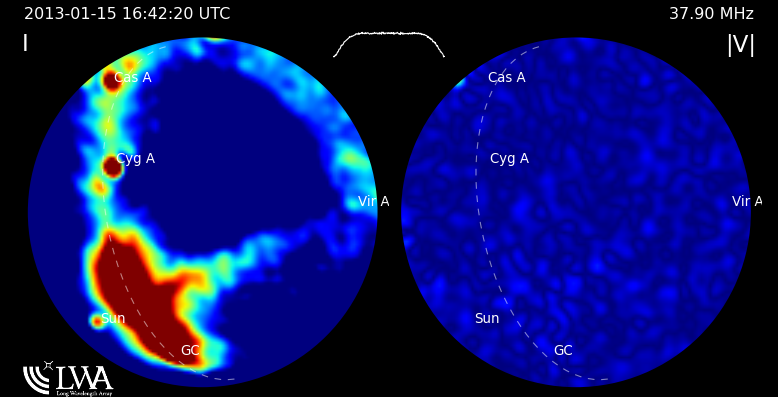The bands 37.5-38 (secondary) and 38-38.25 MHz (primary) are allocated to the radio astronomy service in the United States and in other parts of the world. This frequency range is considered low frequency (long wavelength) for radio astronomy, since it is not much above the ionospheric cut-off frequency, which is typically in the ~5-30 MHz range, depending on solar activity. In the United States, these bands are shared with active (transmitting) services.
Radio astronomy observing in this band is challenging since radio frequency interference may propagate from a long distance away and ruin observations being obtained with very sensitive radio telescopes. The Long Wavelength Array (LWA), located on the site of the Very Large Array radio telescope near Socorro, New Mexico, is one of the few major instruments that uses this band.
At these frequencies, the Sun, the Milky Way galaxy, and a few supernova remnants are among the very brightest sources in the sky.
|
Frequency Bands |
| Band | Use | Service | Table |
| 37.5 - 38.25 MHz | Low Frequency Radio Astronomy | Radio Astronomy | - |
External Links:
Associated Files:

An image of the sky at a frequency of 37.9 MHz, obtained by the Long Wavelength Array (LWA).
Each image shows the full sky, down to the horizon at the image's edge. Depending on the current operating mode of the LWA's Prototype All-Sky Imager experiment, there may be one or two images. If there is one, it shows the total intensity — the power coming from each point on the sky. If there are two, the left will show the total intensity, and the right will show the intensity of circularly polarized radio waves.
At the upper left you can see the average time of the data that went into the image (given in UTC, which is basically the same as Greenwich Mean Time). There is no time gap between the images: we are imaging sky in real time with a 100% duty cycle. At the upper right is the central frequency of the image. In the center is a 100 kHz bandwidth spectrum from a single antenna and polarization; the images are produced from the middle 75 kHz.
Finally, we've labeled the brightest objects in the sky:
Cas A — a supernova remnant
Vir A — a supergiant elliptical galaxy also known as M87
Tau A — the Crab Nebula, a supernova remnant
Cyg A — a bright radio galaxy
Jup — Jupiter, which only can be seen when it is bursting
Sun — the Sun, which can become so bright that it wipes out everything else in the image!
Dashed line — the plane of our galaxy
GC — the center of our galaxy
Of course, there will sometimes be points in our image other than these labeled ones! Most of these are due to radio frequency interference (RFI): radio emissions from sources other than the sky. The sky will sometimes be wiped out by bright RFI, particularly at low frequencies and during the day. However, some blips just may be something new: flares from Hot Jupiters or magnetars; radio counterparts to gamma-ray bursts; or something totally new and unexpected. Our computers will be monitoring these movies to let us know when something unusual pops up!
Display this entry in a page by itself
Edit
|
|
|
|